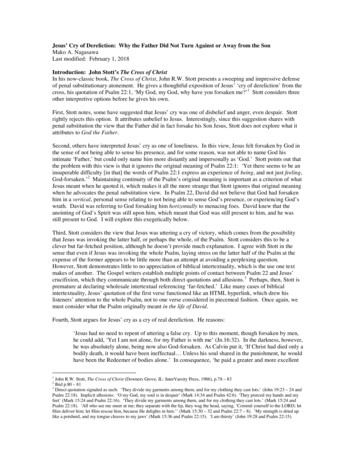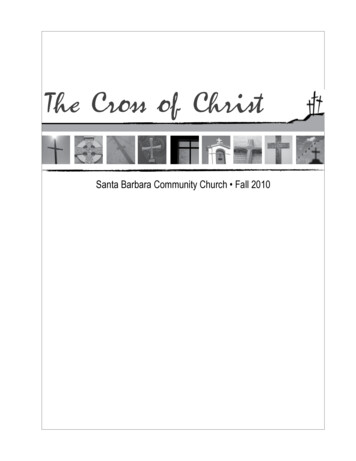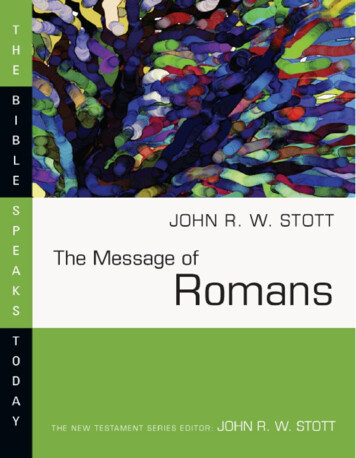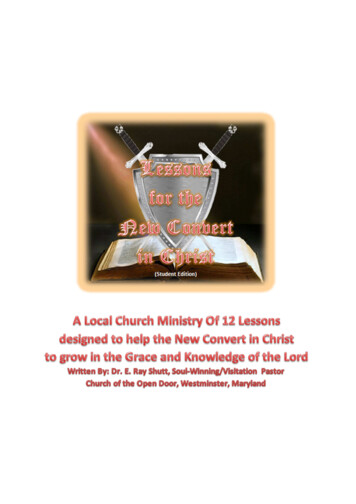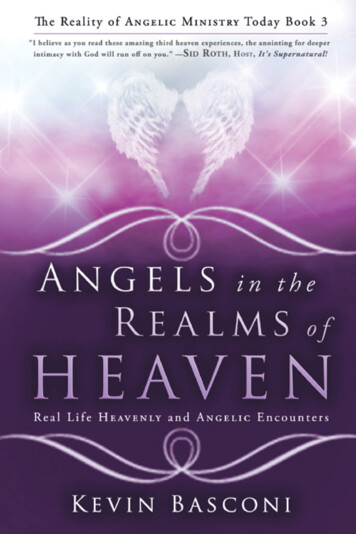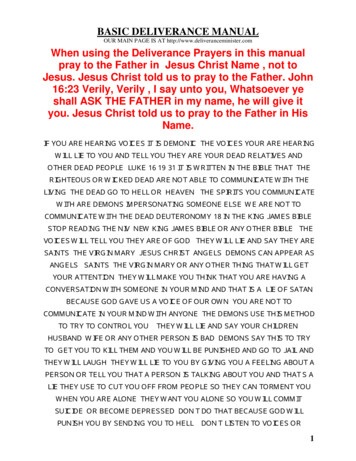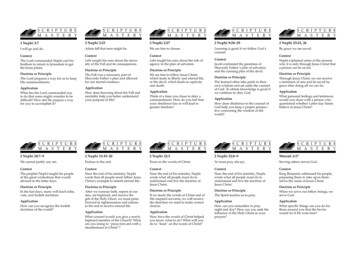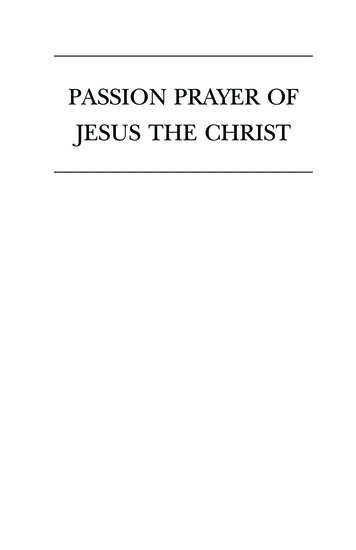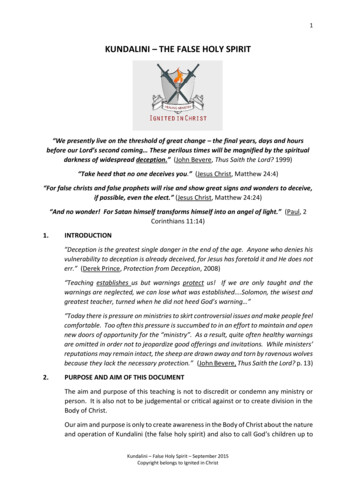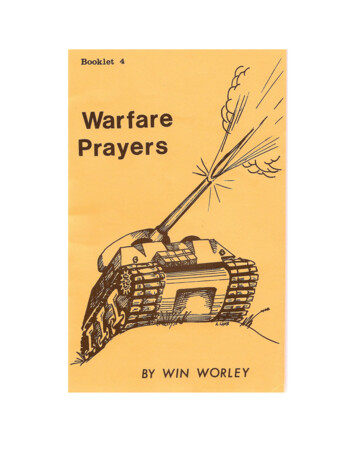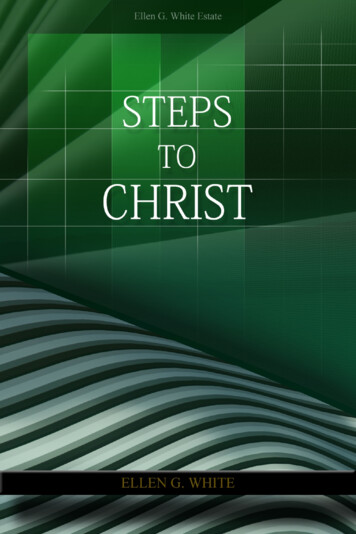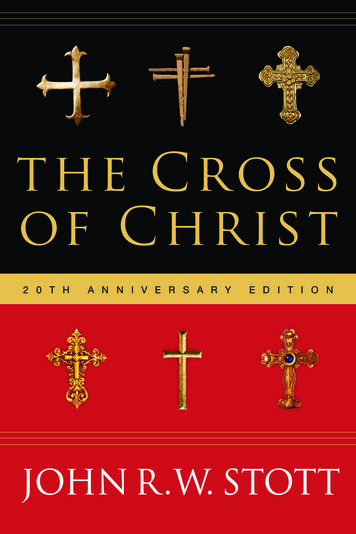
Transcription
The Cr ossof Christ2 0 t hA n n i v e r s a r yE d i t i o nJohn R. W. Stott
“God forbid that I should boastof anything but the crossof our Lord Jesus Christ”GALATIANS 6:14 NEB
Other Books by John R. W. StottBasic Christian LeadershipBaptism & FullnessBasic ChristianityChristian Mission in the Modern WorldThe Contemporary ChristianEvangelical TruthThe Gospel & the End of TimeThe Incomparable ChristThe Message of ActsThe Message of EphesiansThe Message of GalatiansThe Message of 1 & 2 ThessaloniansThe Message of 1 Timothy & TitusThe Message of 2 TimothyThe Message of the Sermon on the MountWhy I Am a ChristianYour Mind MattersBooklets by John R. W. StottThe Authority of the BibleBecoming a ChristianBeing a ChristianBible Studies by John R. W. StottActsThe BeatitudesChristEphesiansGalatiansRomansSermon on the MountScripture1 & 2 Thessalonians1 Timothy & Titus2 Timothy
THE C ROSSOF C HRIST2 0 T HA N N I V E R S A R YE D I T I O NJOHN R. W. STOTTFOREWORD BY ALISTER MCGRATH
InterVarsity PressP.O. Box 1400, Downers Grove, IL 60515-1426Internet: www.ivpress.comE-mail: email@ivpress.com John R. W. Stott 1986, 2006Published in the United States of America by InterVarsity Press, Downers Grove, Illinois, with permission from Inter-VarsityPress, England.All rights reserved. No part of this book may be reproduced in any form without written permission from InterVarsity Press.InterVarsity Press is the book-publishing division of InterVarsity Christian Fellowship/USA , a student movement active oncampus at hundreds of universities, colleges and schools of nursing in the United States of America, and a member movementof the International Fellowship of Evangelical Students. For information about local and regional activities, write PublicRelations Dept., InterVarsity Christian Fellowship/USA, 6400 Schroeder Rd., P.O. Box 7895, Madison, WI 53707-7895, orvisit the IVCF website at www.intervarsity.org .All Scripture quotations, unless otherwise indicated, are taken from the Holy Bible, New International Version . NIV .Copyright 1973, 1978, 1984 by International Bible Society. Used by permission of Hodder and Stoughton Ltd. All rightsreserved. “NIV” is a registered trademark of International Bible Society. UK trademark number 1448790. Distributed in NorthAmerica by permission of Zondervan Publishing House.Cover design: Cindy KipleCover image: Image source/Getty Images Mike Bentley/iStockphoto Lisa Ison/iStockphotoDon Farrall/Getty Imagesfstop123/iStockphoto cstar55/iStockphotoISBN 978-0-8308-6636-6
Dedicated toFrances Wbitebeadin gratitude for 30 years of outstandinglyloyal and efficient service1956-1986
CONTENTSForeword to the 2006 Edition . . . . . . . . . . . . . . . . . . . . . . . . . .9Preface to the Original Edition . . . . . . . . . . . . . . . . . . . . . . . . . .13Abbreviations . . . . . . . . . . . . . . . . . . . . . . . . . . . . . . . . . . .19I. APPROACHING THE CROSS1 The Centrality of the Cross . . . . . . . . . . . . . . . . . . . . . . . .232 Why Did Christ Die? . . . . . . . . . . . . . . . . . . . . . . . . . . .513 Looking Below the Surface . . . . . . . . . . . . . . . . . . . . . . . .66II. THE HEART OF THE CROSS4 The Problem of Forgiveness . . . . . . . . . . . . . . . . . . . . . . .895 Satisfaction for Sin . . . . . . . . . . . . . . . . . . . . . . . . . . . . 1126 The Self-Substitution of God . . . . . . . . . . . . . . . . . . . . . . . 133III. THE ACHIEVEMENT OF THE CROSS7 The Salvation of Sinners . . . . . . . . . . . . . . . . . . . . . . . . . 1658 The Revelation of God . . . . . . . . . . . . . . . . . . . . . . . . . . 2009 The Conquest of Evil . . . . . . . . . . . . . . . . . . . . . . . . . . . 223IV. LIVING UNDER THE CROSS10 The Community of Celebration . . . . . . . . . . . . . . . . . . . . . 24911 Self-Understanding and Self-Giving . . . . . . . . . . . . . . . . . . . 26712 Loving Our Enemies . . . . . . . . . . . . . . . . . . . . . . . . . . . 28813 Suffering and Glory. . . . . . . . . . . . . . . . . . . . . . . . . . . . 303Conclusion: The Pervasive Influence of the Cross . . . . . . . . . . . . . . . . . . 329Study Guide . . . . . . . . . . . . . . . . . . . . . . . . . . . . . . . . . . . 343Bibliography . . . . . . . . . . . . . . . . . . . . . . . . . . . . . . . . . . . 353
Name Index. . . . . . . . . . . . . . . . . . . . . . . . . . . . . . . . . . . . 365Subject Index . . . . . . . . . . . . . . . . . . . . . . . . . . . . . . . . . . . 369Scripture Index . . . . . . . . . . . . . . . . . . . . . . . . . . . . . . . . . . 373
FOREWORD TOTHE 2006 EDITIONIn the twenty years since its publication, John Stott’s The Cross of Christ has established itself as the most respected and authoritative evangelical writing on this mostimportant of subjects. It remains the standard work on its great themes, inspiring,challenging, encouraging and informing its many readers. It is, in my view, JohnStott’s greatest and best work, written at the height of his career, when he was sixtyfive years old. We see in its pages more of this great writer’s mind and heart than inany other of his many writings. It is as if he waited until he felt he was ready to writeon so great a theme, enabling him to distil the theological precision, pastoral wisdomand rhetorical gifts of a lifetime. If this is so, it was definitely worth waiting for.Why is this book so important? At one level, its significance lies in its being themasterpiece of the Christian who is widely regarded as one of the greatest Christian writers, speakers, thinkers and leaders of the twentieth century. John Stott wasborn in 1921, the son of Sir Arnold Stott, a leading Harley Street physician, notedfor his agnosticism as much as his medical skills. He was educated at RugbySchool, where he became head boy. Although spiritually inquisitive, he could notat first find any meaningful association between faith and life. As he later recalled:As a typical adolescent, I was aware of two things about myself, though doubtless Icould not have articulated them in these terms then. First, if there was a God, I wasestranged from him. I tried to find him, but he seemed to be enveloped in a fog Icould not penetrate. Secondly, I was defeated. I knew the kind of person I was, andalso the kind of person I longed to be. Between the ideal and the reality there was agreat gulf fixed. I had high ideals but a weak will.11Timothy Dudley-Smith, John Stott: The Making of a Leader, vol. 1 (Leicester, U.K./Downers Grove, Ill.:Inter-Varsity Press, 1999), p. 89.
10THE CROSS OF CHRISTYet this spiritual restlessness came to an end after John Stott heard Eric Nashgive a talk to the Rugby School Christian Union in February 1938. As he recalls,“what brought me to Christ was this sense of defeat and of estrangement, and theastonishing news that the historic Christ offered to meet the very needs of whichI was conscious.” As he later reflected on his conversion:That night at my bedside I made the experiment of faith, and “opened the door” toChrist. I saw no flash of lightning . . . in fact I had no emotional experience at all. Ijust crept into bed and went to sleep. For weeks afterwards, even months, I was unsure what had happened to me. But gradually I grew, as the diary I was writing at thetime makes clear, into a clearer understanding and a firmer assurance of the salvationand lordship of Jesus Christ.2John Stott went on to Cambridge University, taking first-class honors in modern languages, then, as he trained for ministry in the Church of England, in theology. In 1945 he became curate at the London church now firmly associated withhis name and ministry—All Souls, Langham Place. In a highly unusual move, JohnStott was appointed rector of this church in 1950 and remained in this positionfor twenty-five years. During this time, All Souls became the center of John Stott’sdynamic ministry, including pioneering work involving guest services, studentmissions and a punishing speaking schedule which took him all over the world.So what gave such energy to this mission? What resource both propelled JohnStott into this ministry and sustained him throughout? To read this book is to findthe answer. John Stott found—and enables his readers to find—the intellectualand spiritual riches of the cross that sustain the life of discipleship, especially intimes of darkness and difficulty. John Stott’s carefully calibrated analysis of the significance of the cross enables us to gain an appreciation of how “the cross transforms everything . . . [giving] us a new, worshiping relationship to God, a new andbalanced understanding of ourselves, a new incentive to give ourselves in mission,a new love for our enemies, and a new courage to face the perplexities of suffering.”3 At point after point, readers of this book will realize how and why the crossstands at the center of John Stott’s faith and ministry.John Stott would insist, however, that the importance of the book ultimatelylies in the subject itself. There is no greater, no more challenging task for a Christian leader than to set out the meaning of the cross for the church and for theworld. John Stott’s masterly examination takes the form of four major sections:Ibid., pp. 93 94.John Stott, The Cross of Christ (Leicester, U.K./Downers Grove, Ill.: Inter-Varsity Press, 2006), p. 17.23
Foreword to the 2006 Edition11“Approaching the Cross,” “The Heart of the Cross,” “The Achievement of theCross,” and “Living Under the Cross.” The first section offers a survey of Christianhistory, reflecting on the remarkable way in which the cross became the centraltheme and foundational image of the Christian faith.For many readers, however, it is the second and third sections of the work thatbring us to the heart of the gospel. In a bold yet careful investigation of the humansituation, John Stott demonstrates our incapacity to change our own situation. Weare sinners; and how can such sinners hope to stand in the presence of a holy andrighteous God? How can we hope to gain access to such a God when everythingabout our nature seems to stand in our way? John Stott’s answer is classic in itself,and classic in its inspiration: a divine redeemer was needed, able to bring God’ssalvation to the human situation. “Neither Christ alone as man nor the Fatheralone as God could be our substitute. Only God in Christ, God the Father’s own4and only Son made man, could take our place.” The cross is the place at whichGod brings his salvation and revelation to sinful humanity. John Stott’s explorationis marked by a clarity of biblical exposition and precision of theological dissectionwhich few could hope to achieve. It is at present, as it has been for the last twentyyears, the best and most persuasive account of the classic evangelical understanding of the meaning of the cross.The final section of the work explores the relation between the cross and Christian discipleship in the church and world. We are called to abandon “our supposedright to go on our own way,” and come under the authority of the crucified Christ.To deny ourselves is to behave toward ourselves as Peter did toward Jesus when hedenied him three times. The verb is the same (aparneomai). He disowned him, repudiated him, turned his back on him. Self-denial is not denying to ourselves luxuriessuch as chocolates, cakes, cigarettes and cocktails (though it might include this); itis actually denying or disowning ourselves, renouncing our supposed right to go ourown way.5The way we think and the way we act must be shaped by the cross. Thoughthis book deals thoroughly with theories of the atonement, John Stott exploresits relevance far beyond this traditional horizon, examining its implications forChristian discipleship, the sacraments, and the enigmas of faith. John is at hisbest when exploring the link between the cross and spiritual concerns, perhapsnowhere as well as when he explores how Christians are enabled to bear the bur4Ibid., p. 159.Ibid., p. 272.5
12THE CROSS OF CHRISTden of suffering through the cross of Christ.Any book has weaknesses, some intrinsic, others resulting from the passing ofthe years. For example, at certain points, John Stott makes judgments on issues ofbiblical scholarship which might merit revisiting in the light of the last twentyyears of publications in this field. Equally, new works of theological scholarshiphave appeared, moving the discussion on over certain matters. I would personallyjudge that John Stott would not feel any particular need to change any of his mainconclusions in the light of what I would take to be his evaluation of those developments. Nevertheless, it would be helpful to have his response to some of thesescholarly shifts and his assessment of their significance. At other points, the rapidchanges in culture since the book was first written have perhaps left parts of thebook’s final section a little less persuasive than they were on their original appearance. Yet even with the passage of twenty years, the acuteness of John Stott’s judgment remains impressive.This, then, is a book that will amply repay study. Its continuing impact and relevance after the passage of twenty years since its publication suggests that thisbook has all the makings of a classic—a work written in and for one generation,which its successors continue to find important and illuminating.Alister McGrathProfessor of Historical Theology, Oxford UniversityOctober 2005
PREFACE TOTHE ORIGINAL EDITIONI count it an enormous privilege to have been invited by Inter-Varsity Press to writea book on that greatest and most glorious of all subjects, the cross of Christ. I haveemerged from the several years of work involved spiritually enriched, with myconvictions clarified and strengthened, and with a firm resolve to spend the rest ofmy days on earth (as I know the whole redeemed company will spend eternity inheaven) in the liberating service of Christ crucified.It is appropriate t
John Stott went on to Cambridge University, taking first-class honors in mod-ern languages, then, as he trained for ministry in the Church of England, in theol-ogy. In 1945 he became curate at the London church now firmly associated with his name and ministry—All Souls, Langham Place. In a highly unusual move, John Stott was appointed rector of this church in 1950 and remained in this .
